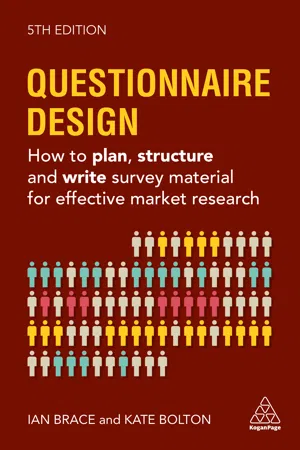
Questionnaire Design
How to Plan, Structure and Write Survey Material for Effective Market Research
- English
- ePUB (mobile friendly)
- Available on iOS & Android
Questionnaire Design
How to Plan, Structure and Write Survey Material for Effective Market Research
About this book
Will your questionnaire work as well as it needs to by today's standards? Use this new edition of the bestselling guide to make sure it does. Good data is central to information-based decision making. Increasing access to online survey software is allowing more organizations to benefit from contact with their customers, employees and the public. However, the challenges facing the questionnaire writer remain and the greater volume of surveys and demands on potential respondents' time is making the task even harder. Your questionnaire needs to work better than ever to keep their attention. Questionnaire Design provides comprehensive and practical guidelines to plan, structure and compose questionnaires across all industries and purposes, ensuring valuable data insights are captured with accuracy and efficiency.You can't write a good questionnaire unless you know exactly what you are trying to achieve. This updated fifth edition recognizes this fundamental challenge, with advice for gaining the clarity needed to plan and focus your questionnaire. It continues to provide guidance for those using interviewer administered surveys, but now reflects the primacy of online and the challenges that brings. With pressure on everyone's time, this revised edition makes it even easier to navigate to the key points with new bullet-pointed takeaways at the end of each chapter.
Frequently asked questions
- Essential is ideal for learners and professionals who enjoy exploring a wide range of subjects. Access the Essential Library with 800,000+ trusted titles and best-sellers across business, personal growth, and the humanities. Includes unlimited reading time and Standard Read Aloud voice.
- Complete: Perfect for advanced learners and researchers needing full, unrestricted access. Unlock 1.4M+ books across hundreds of subjects, including academic and specialized titles. The Complete Plan also includes advanced features like Premium Read Aloud and Research Assistant.
Please note we cannot support devices running on iOS 13 and Android 7 or earlier. Learn more about using the app.
Information
Index
Table of contents
- Introduction
- 01 Defining achievable questionnaire objectives
- 02 Influence of data collection mode on question design
- 03 Planning a questionnaire
- 04 An overview of question types
- 05 Identifying types of data created by questions
- 06 Creating appropriate rating scales
- 07 Asking about behaviour
- 08 Measuring satisfaction, image and attitudes
- 09 Writing effective questions
- 10 Creating a questionnaire for an online survey
- 11 Engaging respondents in online surveys
- 12 Choosing online survey software
- 13 Considerations for interviewer-administered and paper self-completion surveys
- 14 Piloting your questionnaire
- 15 Ethical issues in questionnaire design
- 16 Understanding social desirability bias
- 17 Designing questionnaires for multi-country surveys
- Index